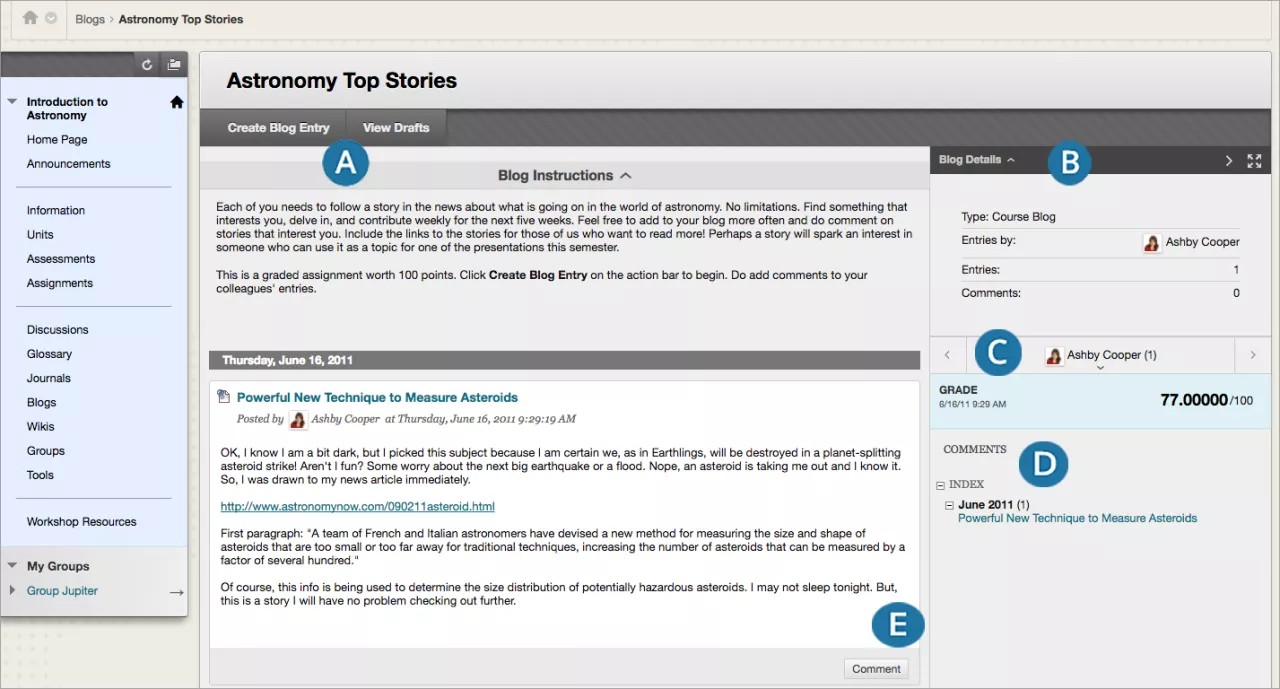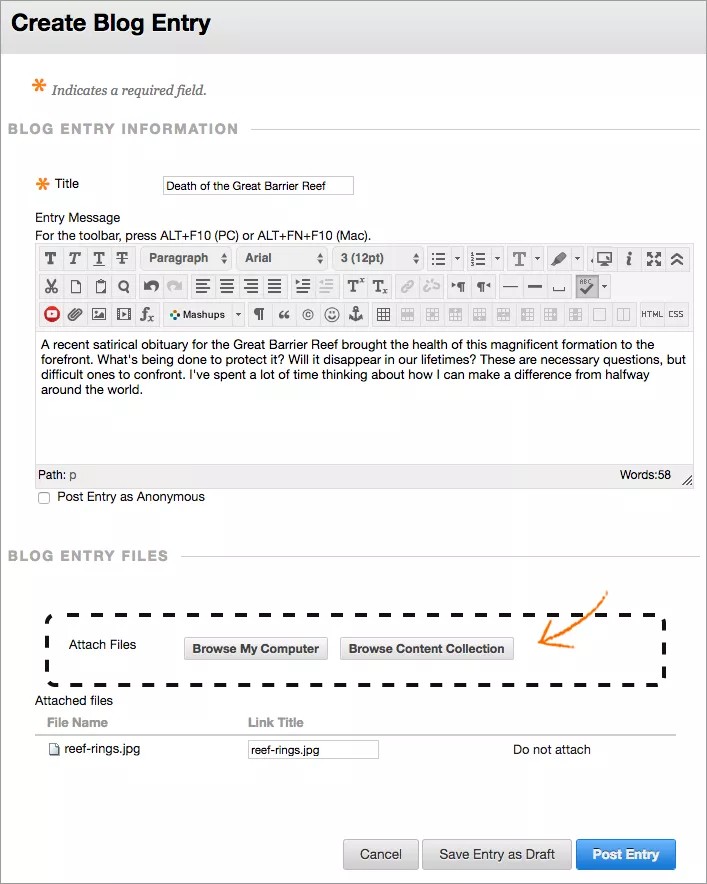This information applies only to the Original Course View. Your institution controls which tools are available.
A blog is your personal online journal. Each blog entry you make can include any combination of text, images, links, multimedia, mashups, and attachments. Blogs are an effective way for you to share knowledge and materials created and collected in the course. You can post entries and add comments to existing blogs. Use your blog to express your ideas and share them with the class.
As the owner of a blog, you can create entries and your instructor and classmates can add comments. A course or a group can also own a blog. In the group area, all members of a group can create entries for the same blog, building upon one another. Any course member can read and comment on a group blog, but can't create an entry if the user isn't a member of the group. Your instructor can also offer comments and grade entries.
If your institution uses avatars or Blackboard profiles, your chosen image appears with your blog.
Where to find blogs
You can find blogs on the course menu or on the Tools page. On the blogs listing page, select the blog topic that you want to read from the alphabetical list.
You can access three types of blogs:
- Course: All enrolled users can create blog entries and add comments to entries.
- Individual: Only the owner of a blog can create blog entries. All other enrolled users can view entries and add comments.
- Group: If your instructor enables the blogs tool for a group, all group members can create blog entries and make comments. All course members can view group blogs, but they only have the option to add comments. You can add entries only to your own group blog.
Your instructor can edit and delete entries in all three blog types and delete user comments.
Blog topic page
The blog topic page is divided into two main sections: the content frame and the sidebar.
- Select Create Blog Entry to create as many blog entries as you want. Select View Drafts to see unpublished entries. Expand the Blog Instructions section to review the blog instructions and any goals your instructor may have aligned with the blog.
- In the sidebar, expand the Blog Details section to view the blog information, including if comments were made. Expand the section to view a list of who else has made blog entries.
- Select a name to view the entries. The Grade section appears if your instructor enabled grading for the blog. You can see if your blog entries have been graded.
- Comments show who has added thoughts to the post. Select Index to view the titles of your selected entries for either the week or the month, based on the settings your instructor makes during blog creation. The most recent entry title appears first.
Create a blog entry
Only your instructor can create a blog. After the blog is created, you can create blog entries.
- On the Blogs listing page, select a blog title.
- On the blog's topic page, select Create Blog Entry.
- Type a title and entry.
- If enabled and appropriate, select the check box for Post Entry as Anonymous.
- Select Browse My Computer to upload a file from your computer. You can also attach a file from the repository: Course Files or the Content Collection.
-OR-
Drag files from your computer to the "hot spot" in the Attach Files area. If your browser allows, you can also drag a folder of files. The files will upload individually. If the browser doesn't allow you to submit your assignment after you upload a folder, select Do not attach in the folder's row to remove it. You can drag the files individually and submit again.
You won’t be able to drag files to upload if your institution uses an older version of Blackboard Learn.
You can use the file name or provide another name for the file.
- Select Post Entry to submit the blog entry or select Save Entry as Draft to add the entry later.
Watch a video about blogs
The following narrated video provides a visual and auditory representation of some of the information included on this page. For a detailed description of what is portrayed in the video, open the video on YouTube, navigate to More actions, and select Open transcript.
Video: Create and edit blog entries explains blogs.
View blog drafts
If you saved a blog entry to edit later, select View Drafts on the blog topic page. Select the title of the entry to edit and post.
Comment on a blog entry
You can comment on one another’s blog entries, whether they belong to an individual, the course, or a group. Your instructor determines if you can make anonymous comments and if you may delete blog comments.
On the blog's topic page, select a user’s name in the sidebar to view a blog. The user’s blog entries open in the content frame. Select Comment to add your thoughts.
Edit or delete a blog entry
Your instructor determines if you're allowed to edit or delete your blog entries. On the blog's topic page, access the entry's menu and select Edit or Delete. Deleting a blog entry is final and irreversible.
View blog grades
After your instructor grades your blog entries, you can view your grade in two places. The grading information appears in the Grade section on the blog's topic page and in My Grades. You can also view your instructor's feedback and the date the grade was assigned. To learn more, see Grades.
Rubrics
If your instructor associated a rubric with the blog and made it available, select View Rubric in the Grade section to display grading criteria.
Troubleshooting
- If you're removed from a course, you won't have access to any blogs. If you're removed from a course after individual blogs are created, all your entries and comments are deleted. If you're removed from a course after course blogs are created, all your entries and comments are retained, but your name is changed to "Anonymous."
- If your instructor deleted the blog while you're posting, the blog and all comments are deleted.
- If your instructor makes a blog unavailable while you're posting, the blog remains visible to your instructor only.
- If your instructor changes the Allow Users to Edit and Delete Entries setting, entries remain but you can't edit them.
- If your instructor changes the Allow Users to Delete Comments setting, comments remain but you can't edit them.


